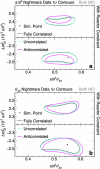Joint neutrino oscillation analysis from the T2K and NOvA experiments
- PMID: 41125778
- PMCID: PMC12545204
- DOI: 10.1038/s41586-025-09599-3
Joint neutrino oscillation analysis from the T2K and NOvA experiments
Abstract
The landmark discovery that neutrinos have mass and can change type (or flavour) as they propagate-a process called neutrino oscillation1-6-has opened up a rich array of theoretical and experimental questions being actively pursued today. Neutrino oscillation remains the most powerful experimental tool for addressing many of these questions, including whether neutrinos violate charge-parity (CP) symmetry, which has possible connections to the unexplained preponderance of matter over antimatter in the Universe7-11. Oscillation measurements also probe the mass-squared differences between the different neutrino mass states (Δm2), whether there are two light states and a heavier one (normal ordering) or vice versa (inverted ordering), and the structure of neutrino mass and flavour mixing12. Here we carry out the first joint analysis of datasets from NOvA13 and T2K14, the two currently operating long-baseline neutrino oscillation experiments (hundreds of kilometres of neutrino travel distance), taking advantage of our complementary experimental designs and setting new constraints on several neutrino sector parameters. This analysis provides new precision on the mass difference, finding in the normal ordering and in the inverted ordering, as well as a 3σ interval on δCP of [-1.38π, 0.30π] in the normal ordering and [-0.92π, -0.04π] in the inverted ordering. The data show no strong preference for either mass ordering, but notably, if inverted ordering were assumed true within the three-flavour mixing model, then our results would provide evidence of CP symmetry violation in the lepton sector.
© 2025. The Author(s).
Conflict of interest statement
Competing interests: The authors declare no competing interests.
Figures













References
-
- Fukuda, Y. et al. Evidence for oscillation of atmospheric neutrinos. Phys. Rev. Lett.81, 1562–1567 (1998).
-
- Fukuda, S. et al. Determination of solar neutrino oscillation parameters using 1496 days of Super-Kamiokande-I data. Phys. Lett. B539, 179–187 (2002).
-
- Ahmad, Q. R. et al. Measurement of the rate of νe + d → p + p + e− interactions produced by 8B solar neutrinos at the Sudbury Neutrino Observatory. Phys. Rev. Lett.87, 071301 (2001). - PubMed
-
- Ahmad, Q. R. et al. Direct evidence for neutrino flavor transformation from neutral-current interactions in the Sudbury Neutrino Observatory. Phys. Rev. Lett.89, 011301 (2002). - PubMed
-
- Eguchi, K. et al. First results from KamLAND: evidence for reactor antineutrino disappearance. Phys. Rev. Lett.90, 021802 (2003). - PubMed
MeSH terms
LinkOut - more resources
Full Text Sources
Miscellaneous

